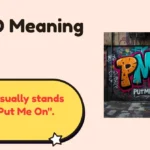If you’ve stumbled across the acronym PMO, you might’ve been left scratching your head. Is it a business term? A text slang? Or something trending on TikTok? The truth is, PMO has multiple meanings depending on where you see it.
In professional circles, PMO often refers to the Project Management Office, a powerhouse that drives efficiency in organizations. In casual texting or social media, though, PMO takes on a whole different vibe.
In this article, we’ll break down every context where PMO shows up—from slang to corporate boardrooms. You’ll learn what it means in texting, how it’s used on platforms like Snapchat or TikTok, and why it’s a critical structure in businesses worldwide.
We’ll also explore PMO software, certifications, challenges, benefits, and the future of PMO in a fast-changing world.
Let’s dive in.
PMO Meaning in Text Messages
When used in casual texting, PMO usually stands for “Put Me On”. This slang phrase is popular among younger crowds, especially Gen Z. It means:
- Introduce me to someone (like a crush or new friend).
- Hook me up with something (like music, fashion tips, or opportunities).
- Connect me with the latest trend.
Example in texting:
- Friend A: That playlist is fire.
- Friend B: PMO to those songs!
Here, “PMO” is basically shorthand for share it with me.
It’s direct, easy, and fits perfectly into the short, snappy style of digital conversations.
PMO on TikTok, Snapchat, and Instagram
Social platforms often reshape slang, and PMO thrives here. On TikTok, Snapchat, and Instagram, PMO is used in captions, hashtags, or comments to ask for:
- Connections: “PMO with your friend” = introduce me.
- Content recommendations: “PMO to a good Netflix show.”
- Style inspiration: “PMO to that outfit plug.”
These platforms have fueled PMO’s rise, turning it into a cultural shorthand.
Example from TikTok: Someone posts a trending dance wearing stylish sneakers. In the comments, you’ll see: PMO to the kicks! meaning, tell me where to get those shoes.
PMO in Urban Dictionary
The Urban Dictionary entry for PMO reflects how slang evolves organically. Users define PMO in multiple ways, but the most common one is:
PMO = Put Me On. Used to ask for an introduction, recommendation, or plug.
It also includes playful twists, sometimes with slightly different meanings, but overall it revolves around connection and access.
Urban Dictionary entries can be colorful, but they often show how slang spreads from one group to mainstream culture.
Variations of PMO in Slang
Like many acronyms, PMO has variations depending on the community using it. Some related or mistaken versions include:
- PMOY – Put Me On You (more flirtatious, often seen in DMs).
- PMO wit it – a playful way to say “I’m interested, share it with me.”
- PMO bro – a casual request among friends.
Slang is fluid. What starts in one group can shift meaning in another. That’s why context is everything when decoding acronyms like PMO.
PMO Meaning in Business
Switch gears, and PMO has a very different identity in the professional world. In business and project management, PMO stands for Project Management Office.
This isn’t slang—it’s an official structure inside organizations that helps ensure projects run smoothly, on time, and within budget. Companies rely on PMOs to standardize processes, improve project success rates, and align projects with strategic goals.
Without a PMO, projects often suffer from scope creep, miscommunication, or wasted resources.
PMO Definition and Objectives
The Project Management Institute (PMI) defines a PMO as:
A group or department that defines and maintains project management standards across an organization.
Core objectives of a PMO include:
- Establishing consistent project management practices.
- Ensuring resources are allocated wisely.
- Providing oversight and reporting to leadership.
- Driving continuous improvement in project delivery.
In simple terms, a PMO is the backbone of organized project management.
Types of PMO
Not all PMOs look the same. Businesses tailor them to their needs. The three main types are:
- Supportive PMO – Offers templates, best practices, and training but doesn’t enforce compliance.
- Controlling PMO – Monitors projects and ensures teams follow set standards.
- Directive PMO – Directly manages projects, often with dedicated project managers.
Table: PMO Types at a Glance
| PMO Type | Role in Organization | Level of Authority |
|---|---|---|
| Supportive | Provides tools, guidance, resources | Low |
| Controlling | Sets standards and compliance rules | Medium |
| Directive | Directly runs and manages projects | High |
Core Functions of a PMO
A strong PMO covers multiple functions:
- Governance: Ensuring projects follow the right policies and standards.
- Resource Management: Balancing workload and making sure teams have what they need.
- Risk Management: Identifying threats before they derail a project.
- Reporting: Giving executives a clear view of progress.
- Training and Mentorship: Helping staff improve project management skills.
These functions reduce chaos and turn project execution into a repeatable science.
PMO Categories by Organizational Hierarchy
PMOs can also be divided by their scope of influence:
- Enterprise PMO (EPMO): Operates at the top level, aligning all projects with company-wide strategy.
- Departmental PMO: Focuses on projects within a single department, like IT or HR.
- Program/Portfolio PMO: Manages a collection of related projects.
Case Example:
- A tech company might use an EPMO to align all IT projects with digital transformation goals.
- The HR department could run its own Departmental PMO to streamline recruitment software rollouts.
PMO Examples in Real Organizations
Real-world examples show the impact of PMOs:
- NASA uses PMOs to manage complex missions involving thousands of moving parts.
- Bank of America runs PMOs to ensure financial compliance and smooth digital initiatives.
- Healthcare organizations rely on PMOs to manage hospital system upgrades and patient record transitions.
These cases highlight why PMOs are critical for industries where precision, deadlines, and budgets matter.
PMO Software and Tools
A PMO is only as strong as its tools. Common software includes:
- Microsoft Project – A classic for detailed scheduling.
- Jira – Ideal for agile teams.
- Asana – Great for team collaboration.
- Smartsheet – Spreadsheet-style project management.
- Monday.com – Visual workflows with automation.
These tools streamline planning, tracking, and reporting.
PMO Certifications and Memberships
For professionals, certifications boost credibility. Common PMO-related certifications include:
- PMP (Project Management Professional) – PMI’s flagship certification.
- PMO-CP (Certified PMO Professional) – Focused specifically on PMO operations.
- PRINCE2 – Popular in the UK and Europe.
- Agile Certifications (PMI-ACP, SAFe Agilist, etc.) – For agile PMOs.
Professional Memberships:
- Project Management Institute (PMI)
- Association for Project Management (APM)
- International Project Management Association (IPMA)
These communities offer networking, training, and resources.
Common PMO Challenges
Running a PMO isn’t without bumps in the road. Common challenges include:
- Resistance to change – Teams often prefer old methods.
- Budget constraints – PMOs can be seen as expensive overhead.
- Lack of executive support – Without buy-in, PMOs struggle to make an impact.
- Scalability – What works for small projects may not scale company-wide.
Successful PMOs tackle these with clear communication, leadership support, and measurable results.
PMO ROI and Benefits
Despite challenges, the benefits of a PMO are massive:
- Higher project success rates.
- Better alignment with strategic goals.
- Reduced costs from failed projects.
- Improved resource utilization.
Fact: According to PMI research, organizations with strong PMOs save up to 28% of wasted project investment compared to those without.
PMO vs Project Manager
Many confuse the two, but they’re not the same.
- PMO = an organizational unit that sets standards, manages resources, and oversees multiple projects.
- Project Manager = an individual who leads a specific project from start to finish.
Analogy:
If a PMO is the coach setting strategies for the whole team, the project manager is the player executing one play on the field.
The Future of PMO
The workplace is changing, and so is the PMO. Future trends include:
- Agile PMOs: Shifting from rigid rules to adaptable frameworks.
- AI and Automation: Tools that forecast risks or auto-generate reports.
- Remote-first management: Cloud-based PMOs handling distributed teams.
PMOs of tomorrow will focus on flexibility, data-driven insights, and digital transformation.
Quick Comparison Table – PMO Meanings
| Context | PMO Meaning | Usage Example |
|---|---|---|
| Texting/Slang | Put Me On | “PMO to that new song!” |
| Social Media | Put Me On (trend-based) | “PMO to your skincare routine on TikTok.” |
| Business | Project Management Office | “Our PMO ensures all projects align with strategy.” |
FAQs About PMO
What does PMO mean in texting?
It usually means “Put Me On”, a slang phrase asking someone to share or connect you with something.
What is the full form of PMO in business?
In business, PMO stands for Project Management Office.
Why is a PMO important in organizations?
A PMO improves project success rates, reduces risks, and ensures alignment with company strategy.
What are the main types of PMO?
The three main types are Supportive, Controlling, and Directive PMOs.
How is a PMO different from a Project Manager?
A PMO oversees multiple projects and sets standards, while a project manager runs one specific project.
Conclusion
Whether you’re scrolling on TikTok or sitting in a boardroom, PMO carries weight—but in very different ways. In slang, it’s about connections, introductions, and being “put on” to something new. In business, it’s a structured office that drives project efficiency and strategy.
The next time you see PMO, remember the context. Is it a friend asking you to share a playlist, or a company ensuring its billion-dollar projects succeed? Either way, you’ll know exactly what it means.











